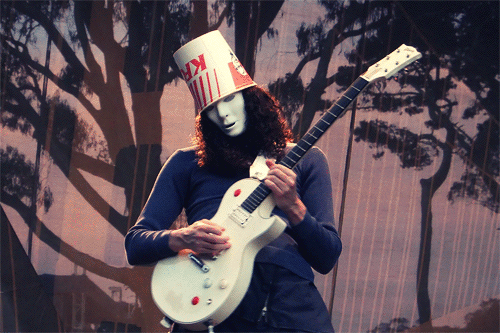CriedWhenBrucieLeft
Meme Only Account
BUCKETHEAD...

Thought I'd open a Buckethead thread!
Buckethead has been around since the late eighties/early nineties and was in early bands including Deli Creeps & the Bill Laswell assembled Praxis. He's had numerous other bands/side-projects, mostly revolving around Buckethead himself; some of them invented, it would seem, simply to circumvent contracts with various record labels. He was also in Guns N' Roses between 2000 - 2004.
Buckethead is Brian Patrick Carroll. There's not a great deal of genuine detail online about the guy behind the mask, although plenty of amusing speculation; the goofy, comedic, slightly creepy persona is really all part of the charm. His identity, where he's from, what age he is, etc; none of this seems to have been confirmed by Carroll. Very few people within the music industry, who actually know him personally (& this would seem to be very few in number), speak about Carroll publicly.
Carroll has seldom spoken publicly about his alter-ego/stage-persona Buckethead; and Buckethead doesn't speak. Destroy All Monsters (Guitar Player Magazine 1996) is probably the most detailed interview with Carroll (Buckethead had a column in Guitar Player Magazine in the early nineties) until the revelationary Coming Alive podcast interview of July 2017. There are very few genuine photographs of Carroll online (there are probably only two of him that are real; both are from when he was in his teens); and, as touched upon, Buckethead doesn't do interviews, do any real promotion (in a conventional sense), or really do anything publicly.
Buckethead has always released a lot of music, especially since the mid-2000s. More recently his vehicle for releasing albums has been via his Buckethead Pikes series, small half-hour albums that he self-releases via Bandcamp; he has released over 250 Pikes since mid-2011.
Buckethead returned to touring in April 2016 after a three year hiatus...

More information on Buckethead can be found here:
Buckethead (Wiki)
Buckethead Discography (Wiki)
Buckethead Pikes
Buckethead is probably best known for his early work on the album Colma (1998):
And for songs like Nottingham Lace (2005), Soothsayer (2006), and Jordan (2009):
Uh...

Thought I'd open a Buckethead thread!

Buckethead has been around since the late eighties/early nineties and was in early bands including Deli Creeps & the Bill Laswell assembled Praxis. He's had numerous other bands/side-projects, mostly revolving around Buckethead himself; some of them invented, it would seem, simply to circumvent contracts with various record labels. He was also in Guns N' Roses between 2000 - 2004.
Buckethead is Brian Patrick Carroll. There's not a great deal of genuine detail online about the guy behind the mask, although plenty of amusing speculation; the goofy, comedic, slightly creepy persona is really all part of the charm. His identity, where he's from, what age he is, etc; none of this seems to have been confirmed by Carroll. Very few people within the music industry, who actually know him personally (& this would seem to be very few in number), speak about Carroll publicly.
Carroll has seldom spoken publicly about his alter-ego/stage-persona Buckethead; and Buckethead doesn't speak. Destroy All Monsters (Guitar Player Magazine 1996) is probably the most detailed interview with Carroll (Buckethead had a column in Guitar Player Magazine in the early nineties) until the revelationary Coming Alive podcast interview of July 2017. There are very few genuine photographs of Carroll online (there are probably only two of him that are real; both are from when he was in his teens); and, as touched upon, Buckethead doesn't do interviews, do any real promotion (in a conventional sense), or really do anything publicly.
Buckethead has always released a lot of music, especially since the mid-2000s. More recently his vehicle for releasing albums has been via his Buckethead Pikes series, small half-hour albums that he self-releases via Bandcamp; he has released over 250 Pikes since mid-2011.
Buckethead returned to touring in April 2016 after a three year hiatus...

More information on Buckethead can be found here:
Buckethead (Wiki)
Buckethead Discography (Wiki)
Buckethead Pikes
Buckethead is probably best known for his early work on the album Colma (1998):
And for songs like Nottingham Lace (2005), Soothsayer (2006), and Jordan (2009):
Uh...
Young Buckethead "Demonstration" (Secret Recipe DVD)
Young Buckethead (Vol. 1 Disc 1) (DVD)
Young Buckethead (Vol. 1 Disc 2) (DVD)
Young Buckethead (Vol. 2 Disc 1) (DVD)
Young Buckethead (Vol. 2 Disc 2) (DVD)
Young Buckethead (Vol. 1 Disc 1) (DVD)
Young Buckethead (Vol. 1 Disc 2) (DVD)
Young Buckethead (Vol. 2 Disc 1) (DVD)
Young Buckethead (Vol. 2 Disc 2) (DVD)
Buckethead at an Airport (Secret Recipe DVD)
Les Claypool Subleases to Buckethead (199?)
Crazy Robot Dance (2006)
Brian "Brain" Mantia: Give The Drummer Some (2008)
Buckethead Dancing to Thriller (2009)
Les Claypool Subleases to Buckethead (199?)
Crazy Robot Dance (2006)
Brian "Brain" Mantia: Give The Drummer Some (2008)
Buckethead Dancing to Thriller (2009)
Mishawaka (Set 1) (2006)
Mishawaka (Set 2) (2006)
Italian American Social Club (Set 1) (2006)
Italian American Social Club (Set 2) (2006)
Mishawaka (Set 2) (2006)
Italian American Social Club (Set 1) (2006)
Italian American Social Club (Set 2) (2006)
Buckethead's Gear (2013):
UberProAudio article on Buckethead's guitars, pedals, amps, etc.
Buckethead Guitar Gear Rig and Equipment
UberProAudio article on Buckethead's guitars, pedals, amps, etc.
Buckethead Guitar Gear Rig and Equipment
Last edited:





